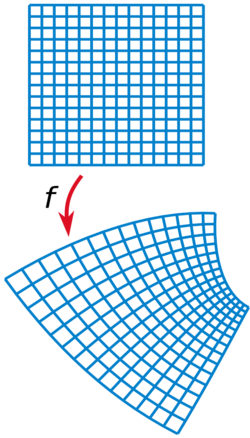Conformally flat manifold
A (pseudo-)Riemannian manifold is conformally flat if each point has a neighborhood that can be mapped to flat space by a conformal transformation.
In practice, the metric [math]\displaystyle{ g }[/math] of the manifold [math]\displaystyle{ M }[/math] has to be conformal to the flat metric [math]\displaystyle{ \eta }[/math], i.e., the geodesics maintain in all points of [math]\displaystyle{ M }[/math] the angles by moving from one to the other, as well as keeping the null geodesics unchanged,[1] that means there exists a function [math]\displaystyle{ \lambda(x) }[/math] such that [math]\displaystyle{ g(x) = \lambda^2(x)\, \eta }[/math], where [math]\displaystyle{ \lambda(x) }[/math] is known as the conformal factor and [math]\displaystyle{ x }[/math] is a point on the manifold.
More formally, let [math]\displaystyle{ (M,g) }[/math] be a pseudo-Riemannian manifold. Then [math]\displaystyle{ (M,g) }[/math] is conformally flat if for each point [math]\displaystyle{ x }[/math] in [math]\displaystyle{ M }[/math], there exists a neighborhood [math]\displaystyle{ U }[/math] of [math]\displaystyle{ x }[/math] and a smooth function [math]\displaystyle{ f }[/math] defined on [math]\displaystyle{ U }[/math] such that [math]\displaystyle{ (U,e^{2f} g) }[/math] is flat (i.e. the curvature of [math]\displaystyle{ e^{2f} g }[/math] vanishes on [math]\displaystyle{ U }[/math]). The function [math]\displaystyle{ f }[/math] need not be defined on all of [math]\displaystyle{ M }[/math].
Some authors use the definition of locally conformally flat when referred to just some point [math]\displaystyle{ x }[/math] on [math]\displaystyle{ M }[/math] and reserve the definition of conformally flat for the case in which the relation is valid for all [math]\displaystyle{ x }[/math] on [math]\displaystyle{ M }[/math].
Examples
- Every manifold with constant sectional curvature is conformally flat.
- Every 2-dimensional pseudo-Riemannian manifold is conformally flat.[1]
- The line element of the two dimensional spherical coordinates, like the one used in the geographic coordinate system,
- [math]\displaystyle{ ds^2 = d\theta^2 + \sin^2 \theta \, d\phi^2 \, }[/math],[2] has metric tensor [math]\displaystyle{ g_{ik} = \begin{bmatrix} 1 & 0 \\ 0 & sin^2 \theta \end{bmatrix} }[/math] and is not flat but with the stereographic projection can be mapped to a flat space using the conformal factor [math]\displaystyle{ 2 \over (1+r^2) }[/math], where [math]\displaystyle{ r }[/math] is the distance from the origin of the flat space,[3] obtaining
- [math]\displaystyle{ ds^2 = d\theta^2 + \sin^2 \theta \, d\phi^2 \, = \frac{4}{(1+r^2)^2}(dx^2 +dy^2) }[/math].
- A 3-dimensional pseudo-Riemannian manifold is conformally flat if and only if the Cotton tensor vanishes.
- An n-dimensional pseudo-Riemannian manifold for n ≥ 4 is conformally flat if and only if the Weyl tensor vanishes.
- Every compact, simply connected, conformally Euclidean Riemannian manifold is conformally equivalent to the round sphere.[4]
- The stereographic projection provides a coordinate system for the sphere in which conformal flatness is explicit, as the metric is proportional to the flat one.
- In general relativity conformally flat manifolds can often be used, for example to describe Friedmann–Lemaître–Robertson–Walker metric.[5] However it was also shown that there are no conformally flat slices of the Kerr spacetime.[6]
- For example, the Kruskal-Szekeres coordinates have line element
- [math]\displaystyle{ ds^2 = \left(1-\frac{2GM}{r} \right) dv \, du }[/math] with metric tensor [math]\displaystyle{ g_{ik} = \begin{bmatrix} 0 & 1-\frac{2GM}{r} \\ 1-\frac{2GM}{r} & 0 \end{bmatrix} }[/math] and so is not flat. But with the transformations [math]\displaystyle{ t = (v + u)/2 }[/math] and [math]\displaystyle{ x = (v - u)/2 }[/math]
- becomes
- [math]\displaystyle{ ds^2 = \left(1-\frac{2GM}{r} \right) (dt^2 - dx^2) }[/math] with metric tensor [math]\displaystyle{ g_{ik} = \begin{bmatrix} 1-\frac{2GM}{r} & 0 \\ 0 & -1+\frac{2GM}{r} \end{bmatrix} }[/math],
- which is the flat metric times the conformal factor [math]\displaystyle{ 1-\frac{2GM}{r} }[/math].[7]
See also
References
- ↑ Jump up to: 1.0 1.1 Ray D'Inverno. "6.3 The Weil tensor". Introducing Einstein's Relativity. pp. 88–89.
- ↑ Spherical coordinate system - Integration and differentiation in spherical coordinates
- ↑ Stereographic projection - Properties. The Riemann's formula
- ↑ Kuiper, N. H. (1949). "On conformally flat spaces in the large". Annals of Mathematics 50 (4): 916–924. doi:10.2307/1969587.
- ↑ Garecki, Janusz (2008). "On Energy of the Friedman Universes in Conformally Flat Coordinates". Acta Physica Polonica B 39 (4): 781–797. Bibcode: 2008AcPPB..39..781G.
- ↑ Garat, Alcides; Price, Richard H. (2000-05-18). "Nonexistence of conformally flat slices of the Kerr spacetime" (in en). Physical Review D 61 (12): 124011. doi:10.1103/PhysRevD.61.124011. ISSN 0556-2821. Bibcode: 2000PhRvD..61l4011G.
- ↑ Ray D'Inverno. "17.2 The Kruskal solution". Introducing Einstein's Relativity. pp. 230–231.
 |


